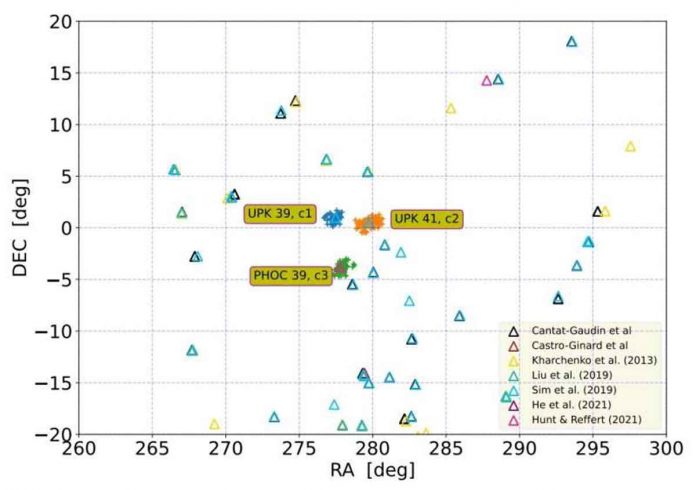Astronomers studied three open clusters near the Aquila Rift cloud using data from the European Space Agency’s Gaia satellite and the Large Sky Area Multi-Object Fiber Spectroscopic Telescope (LAMOST). They discovered that two of them, UPK 39 and UPK 41, form a primordial binary open cluster. The discovery is detailed in a paper published on arXiv.org on July 28.
Open clusters (OCs) are groups of stars that are gravitationally bound to each other and formed from the same giant molecular cloud. More than 1,000 of them have been discovered so far in the Milky Way, and scientists are still looking for more in the hope of discovering a variety of these stellar groupings. Extending the list of known galactic open clusters and studying them in depth could be critical for improving our understanding of our galaxy’s formation and evolution.
A team of astronomers led by Xianhao Ye of the Chinese Academy of Sciences in Beijing, China, recently discovered open clusters in the region surrounding the Aquila Rift cloud. They also looked at three other OCs with similar proper motions and radial velocities: UPK 39, UPK 41, and PHOC 39.
“We investigate three open clusters near the Aquila Rift cloud, named UPK 39 (c1 hereafter), UPK 41 (c2 hereafter) in Sim et al. (2019), and PHOC 39 (c3 hereafter) in Hunt &Reffert (2021),” the researchers wrote in the paper.
The researchers discovered that UPK 39, UPK 41, and PHOC 39 have similar proper motions and that the radial velocity difference between UPK 39 and UPK 41 is less than 3 km/s. UPK 39, UPK 41, and PHOC 39 were estimated to be 6.3, 8.1, and 21.8 million years old, respectively.
According to LAMOST data, UPK 39 and UPK 41 have a median metallicity of about -0.26 dex. This value was calculated by taking the 21 member candidates of each cluster with the lowest metallicity uncertainties into account.
Overall, astronomers believe that UPK 39 and UPK 41 are a primordial binary cluster that formed simultaneously based on relative distances, kinematics, ages, and metallicities. PHOC 39, on the other hand, formed earlier and has a higher metallicity—approximately -0.12 dex.
The researchers also believe that PHOC 39 did not cause the formation of the other two clusters. They do not, however, rule out the possibility that this OC will capture UPK 39 and UPK 41 in the future.
“We conclude that c1 and c2 are a primordial binary open cluster that formed at the same time, and c3 may capture c1, c2 in the future,” the paper’s authors wrote.

